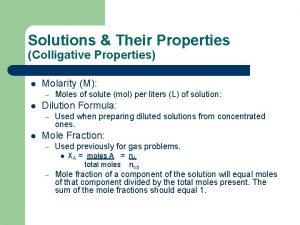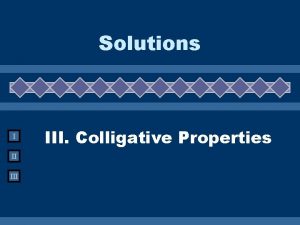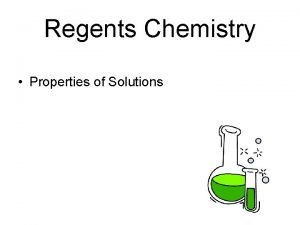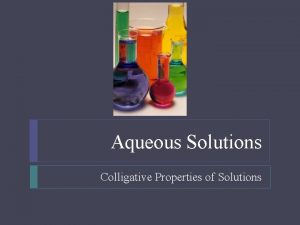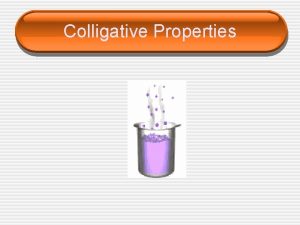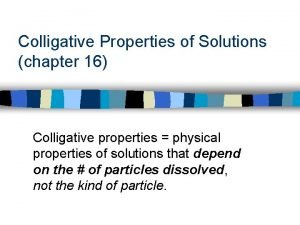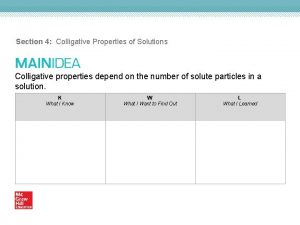Colligative Properties of Solutions Chapter 16 Colligative Properties











- Slides: 11

Colligative Properties of Solutions Chapter 16

Colligative Properties n n Colligative Property: A property that depends only upon the number of solute particles (concentration), and not upon their identity. Three Important Colligative Properties of Solutions. Vapor-pressure lowering n Boiling-point elevation n Freezing-point depression n

Vapor-Pressure Lowering n Vapor pressure: is the pressure exerted by a vapor that is in dynamic equilibrium with its liquid in a closed system. n A solution that contains a solute that is nonvolatile (not easily vaporized) always has a lower vapor pressure than the pure solvent. n This is true because in a solution, solute particles reduce the number of free solvent particles able to escape the liquid.

Vapor-Pressure Lowering n The decrease in a solution’s vapor pressure is proportional to the number of particles the solute makes in solution.

Freezing-Point Depression n Freezing-Point Depression: The difference in temperature between the freezing point of a solution and the freezing point of the pure solvent (water). n The presence of a solute in water disrupts the formation of the orderly pattern of ice. Therefore more kinetic energy must be withdrawn from a solution than from the pure solvent to cause the solution to solidify.

Freezing-Point Depression n The freezing point of a solution is lower than the freezing point of the pure solvent.

Freezing-Point Depression n The magnitude of the freezing-point depression is proportional to the number of solute particles dissolved in the solvent and does not depend upon their identity. n Which would be a better salt for putting on icy roads, Na. Cl or Ca. Cl 2?

Boiling-Point Elevation n Boiling Point: The temperature at which the vapor pressure of the liquid phase equals atmospheric pressure. n Because of the decrease in vapor pressure, additional kinetic energy must be added to raise the vapor pressure of the liquid phase of the solution to atmospheric pressure to initiate boiling.

Boiling-Point Elevation n Boiling-Point Elevation: The difference in temperature between the boiling point of a solution and the boiling point of the pure solvent. n The boiling point of a solution is higher than the boiling point of the pure solvent.

Boiling-Point Elevation n The magnitude of the boiling-point elevation is proportional to the number of solute particles dissolved in the solvent. n It takes additional kinetic energy for the solvent particles to overcome the attractive forces that keep them in the liquid.

THE END n NOW LET’S GET TO SOME CALCULATIONS….
 Ions in aqueous solutions and colligative properties
Ions in aqueous solutions and colligative properties Which solution
Which solution Propriété colligative des solutions
Propriété colligative des solutions Dot
Dot Molarity and molality are colligative properties.
Molarity and molality are colligative properties. Colligative properties definition
Colligative properties definition Van't hoff factor of nacl
Van't hoff factor of nacl Regents
Regents Colligative properties of milk
Colligative properties of milk Colligative properties meaning
Colligative properties meaning Colligative properties worksheet
Colligative properties worksheet Vant hoff factor of glucose
Vant hoff factor of glucose




